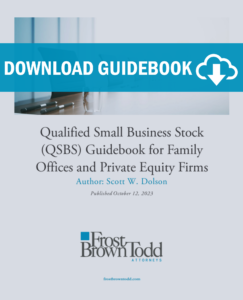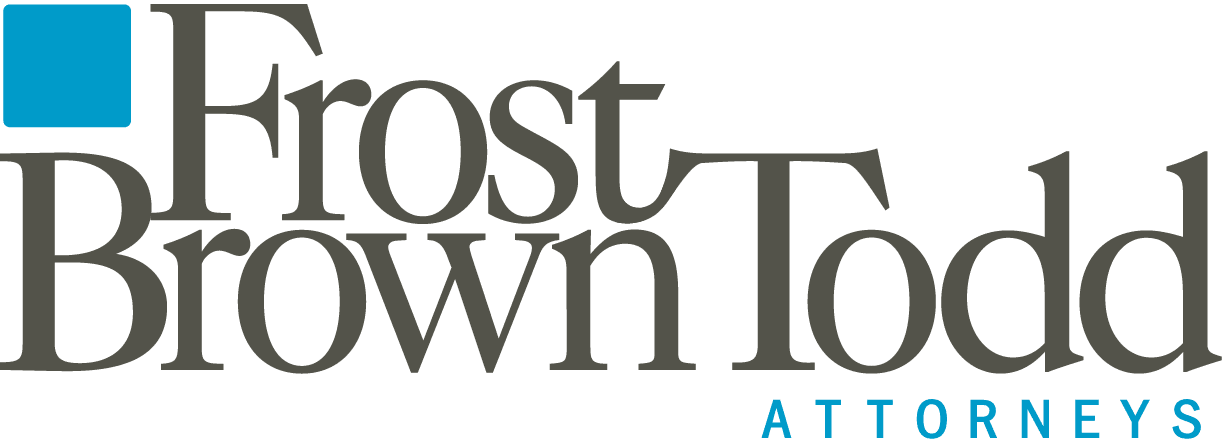This article considers whether there is a role for a self-directed Roth IRA when structuring the ownership of qualified small business stock (QSBS).[1]
This article is one in a series of articles and blogs addressing planning issues relating to QSBS and the workings of Sections 1202 and 1045. During the past five years, the C corporation has gained favor as the entity of choice for many start-ups. Much of this interest can be attributed to the reduction in the federal corporate income tax rate from 35% to 21%, but savvy founders and venture capitalists have also focused on qualifying for Section 1202’s gain exclusion. Efforts by Congress to reduce Section 1202’s benefits over the past several years have failed. Additional information regarding the eligibility requirements for Sections 1202 and 1045 can be found in our QSBS library.
Section 1202 basics
Previous articles have addressed generous tax benefits associated with QSBS, including considering the various requirements that must be satisfied before a stockholder is eligible to claim Section 1202’s gain exclusion.[2] Section 1202 generally caps at $10 million the amount of gain that can be excluded by a taxpayer with respect to a particular issuing corporation’s QSBS.[3] The $10 million cap can be increased by gifting shares of QSBS to other taxpayers, including non-grantor trusts.[4] Gain on the sale of QSBS that exceeds the cap is taxed at capital gains rates.
Factors to take into account when considering the role of Roth IRAs include (i) Section 1202’s gain exclusion is capped, although it is possible to multiply the gain exclusion by gifting QSBS to separate taxpayers or initially acquiring QSBS through multiple taxpayers (e.g., using partnerships or S corporations with multiple owners or simply spreading ownership among multiple related parties), and (ii) Section 1202’s gain exclusion doesn’t require adhering to the Roth IRAs rules, including waiting until the age of 59½ before taking distributions.
Roth IRAs
Roth Individual Retirement Accounts (IRAs) were introduced in 1997.[5] No deduction is allowed for contributions to a Roth IRA, but the Roth IRA’s earnings and distributions are not taxed. Contributions to the Roth IRA for each taxable year are limited to the lesser of (i) the taxpayer’s compensation income, and (ii) then-applicable dollar ceiling ($7,000 in 2024; those 50 and older can make extra $1,000 contributions). Subject to the income limits for a joint return (see below), each spouse can establish and fund a separate Roth IRA.
The 2024 Roth IRA income limit is $161,000 for single tax filers and $240,000 for a joint return. Taxpayers over those limits cannot fund the Roth IRA in the applicable year. However, Roth IRAs can be funded by individuals who exceed the income limits by rolling over funds/investments from traditional IRAs. A traditional IRA rollover is a taxable transaction, but once it is completed, the Roth IRA has dry powder to make investments.
Distributions from a Roth IRA are not required to be made at a certain age, but there is a penalty if earnings are withdrawn prior to 59½, or before the account has been open for at least five years. Contributions to a Roth IRA can be withdrawn at any time without tax or penalty. If a traditional IRA is converted into a Roth IRA, the holder must wait at least five years after the conversion or until age 59½ before withdrawing the converted amount to avoid paying a 10% penalty. Distribution of earnings from a converted IRA are tax-free and penalty-free so long as the owner is 59½ and the money has been held in the converted IRA for at least five years.
An IRA will forfeit its favorable tax treatment if the IRA and its owner engage in a prohibited transaction. These rules can be a concern when a taxpayer invests in private corporation stock. The prohibited transaction rules are complex, but a good rule of thumb is that neither QSBS nor any other private company stock should be held in an IRA if the owner (i) is an officer or director of the issuing corporation, (ii) an employee holding directly or indirectly 10 percent+ of the issuing corporation’s stock, or (iii) a mere investor holding directly or indirectly 50% or more of the issuing corporation stock. The Department of Labor has also suggested in Advisory Opinions that a prohibited transaction could be triggered if an IRA owner receives compensation from a corporation whose stock is held by the IRA.
Roth IRAs have experienced quite a bit of notoriety due to ProPublica’s publication of information about “massive” Roth IRAs.[6] In particular, ProPublica reported that Peter Thiel funded his Roth IRA in 1999 with $1,700 and has since grown that balance to $5 billion through timely purchases of PayPal and Facebook stock. Apparently, Thiel is not alone as ProPublica also reported that the number of Americans with IRAs worth over $5 million tripled to more than 28,000 between 2011 and 2019.[7]
The role of Roth IRAs in structuring the ownership of QSBS
What role does the Roth IRA have to play when founders, employees and investors are structuring how to own QSBS?
- Planning for investors. Assume for purposes of this discussion that an “investor” isn’t an officer or director of the issuing corporation and holds less 10% or less of the corporation’s equity (by vote and value). Holding QSBS in a Roth IRA has the same tax consequences as holding any other stock investment. Gain on the sale of stock (including QSBS) by Roth IRA isn’t taxable, regardless of how much gain there is, and after reaching the age of 59½, distributions of earnings can be made tax-free, so long as five years have passed since the Roth IRA account was opened. With the Roth IRA, there is the potential to follow the Theil mega-IRA strategy and grow a small investment in early-stage companies into a massive holding on a tax-free basis.
A practical restraint on following the Theil strategy is accumulating sufficient funds for investment in the Roth IRA. There are not too many investments opportunities like the one Theil had to grow a $1,700 investment into $5 billion. Given the significant limitations on contributions to IRA’s including the cap on the annual contributions and the income limitations ($161,000 for single filers and $240,000 for married couples), it will be difficult for many investors to fund a Roth IRA. One possibility solution is rolling over funds from traditional IRAs, SEP IRAs, Simple IRAs, or employer plans into the Roth IRA, each of which is a taxable conversion, but doing so may be worth the tax cost if the funds successfully invested.
Given the fact that QSBS has its own gain exclusion under Section 1202 for shares held outside of the Roth IRA, it may make more sense to non-QSBS investments in the Roth IRA. Proceeds from the sale of QSBS held outside of a Roth IRA can be accessed before an individual turns 59½. Perhaps investors should consider acquiring some shares of QSBS in the Roth IRA and some outside of the Roth IRA, if the investor doesn’t have other non-QSBS to acquire through the Roth IRA. If an investor has a crystal ball and knows that the stock investment will turn into another Facebook, perhaps the Roth IRA is the best choice, whether or not the stock qualifies as QSBS. Also, as a practical matter, for some investors the Roth IRA is their best source for investment capital.
The process of investing in QSBS through a Roth IRA will be complicated by the fact that there are a limited number of IRA custodians who support investing in non-publicly traded stock. Although the difference in cost would seldom be a game changer, it is worth pointing out that the overall cost of investing through the Roth IRA will almost always exceed the cost of investing in QSBS outside of IRA.
- Planning for founders. Roth IRAs generally won’t have a role to play in structuring the ownership of founder stock because of the prohibited transaction rules – most founders serve as officers and/or directors. Founders can engage in fruitful planning at the time of formation by spreading their penny founder common stock among multiple family members, family entities (e.g., family limited partnerships) and trusts. For example, if QSBS is acquired through a family LLC/LP, each partner has the potential for a separate $10 million gain exclusion.
- Planning for (non-officer) employees. Non-officer early-stage employees should be able to fund their Roth IRA with their employer’s QSBS, but the issue is not clear-cut given that the Department of Labor has suggested in Advisory Opinions that a prohibited transaction can arise where an IRA owner receives compensation from the issuing corporation.[8] The investment in QSBS must be made to exclusively benefit the Roth IRA, and not benefit the IRA owner or any “disqualified person.”
- Creating custodial Roth IRAs for children. A possible family wealth planning strategy is to acquire QSBS through custodial Roth IRA established for children. When a child reaches the legal age in their state (typically 18 or 21, depending on the state), the custodial Roth IRA will need to be converted to a regular Roth IRA in the child’s name. Unfortunately, custodial Roth IRAs only work if a child has sufficient employment income to support funding the IRA.[9] Parents can make gifts of cash to the child’s custodial Roth IRA, and those funds in turn can be used to purchase QSBS, provided that those gifts are limited annually to the lesser of (i) the child’s compensation income, and (ii) then-applicable dollar ceiling ($7,000 in 2024).
Two potential drawbacks of structuring the acquisition of QSBS through a child’s custodial Roth IRA are that the child assumes control of the IRA account when he or she reaches the age of maturity, and the child won’t be able to access the funds without incurring tax penalties before 59½. Structuring ownership of QSBS through family partnerships, trusts or direct ownership by children (either as the original holder of the QSBS or via a gift of QSBS) does permit more flexibility than working with custodial Roth IRAs. Finally, parent should consider whether it makes the most sense to acquire non-QSBS investments through the custodian Roth IRA while investing in QSBS through family entities or trusts established for their children.
The potential for Roth IRA or QSBS “reform” legislation should be considered during the planning process
The potential for adverse legislation should be taken into consideration when deciding whether to invest in QSBS through Roth IRAs. There was a significant amount of backlash after ProPublica published information regarding massive IRAs, which resulted in the introduction of proposed legislation by Richard Neal to cap at $20 million the value of stock held in a Roth IRA. The legislation has not advanced through Congress but the potential for future legislation should be weighed, particularly when considering acquiring QSBS through the Roth IRA. Section 1202 currently does not include language that would support the continuation of QSBS status for stock distributed from a Roth IRA. Of course, as seen in 2021 when a QSBS “reform” provision worked its way through Congress and barely failed to pass, there is always the risk that legislation targeting QSBS will be reintroduced, tipping the scale towards acquiring speculative stock investments through the Roth IRA.
Summarizing Roth IRA planning considerations
For many investors, both the dollar and income limits on contributions severely restrict the ability to make effective use of a Roth IRA. The prohibited transaction rules further impact the ability of founders and employees to acquire QSBS through a Roth IRA. While it is true that an investor with a crystal ball could potentially duplicate at some level Peter Thiel’s success by obtaining sufficient investment funds through a traditional IRA conversion or using Roth IRA earnings to acquire speculative equity positions. If that approach proves successful and outstrips the gain exclusion that would be available through holding QSBS directly, the investor will have successfully threaded the needle by finding the narrow circumstance where investing in QSBS through the Roth IRA achieves a superior result. Otherwise, it appears to make more economic sense to acquire QSBS outside of a Roth IRA, based on a reasonable assumption that an investor’s potential gain should be reasonably expected to fall below Section 1202’s gain exclusion cap (with and sometimes without gifting QSBS to additional taxpayers).
The other circumstance where investing in QSBS (or any investment for that matter) in a Roth IRA seems reasonable is 1where an investor’s investment funds are concentrated in a Roth IRA. In that situation, what might make the most sense from a tax standpoint rightfully takes a back seat to the practical issue of funding the investment. But under those circumstances, careful attention should be paid to whether the private stock investment could run afoul of the prohibited transaction rules.
There is no role for traditional IRAs when acquiring QSBS
QSBS should be held outside of a traditional IRA. Contributions to traditional IRAs can be deductible subject to limits, and the earnings are not taxable while held in the IRA. But traditional IRAs are poor vehicles for holding QSBS because while the traditional IRA’s earnings are not taxable, distributions are fully taxable at ordinary income rates. In contrast, Section 1202 provides a gain exclusion when QSBS is sold or exchanged that isn’t dependent on holding the stock in a retirement account. Further, if QSBS is held directly by the IRA owner, gain in excess of the cap is taxed at 23.8% rather than ordinary income rates.
An IRA owner should consider converting the traditional IRA to a Roth IRA if the IRA is the only source of funds to acquire QSBS. The tax cost triggered by conversion could prove to be a small price to pay for gaining access to both the funds and the Roth IRA’s favorable tax features discussed above.
More QSBS Resources
- Dealing with Excess Accumulated Earnings in a Qualified Small Business – A Section 1202 Planning Guide
- Section 1202 (QSBS) Planning for Sales, Redemptions and Liquidations
- Can Stockholders of Employee Leasing or Staffing Companies Claim Section 1202’s Gain Exclusion?
- Qualified Small Business Stock (QSBS) Guidebook for Family Offices and Private Equity Firms
- Conversions, Reorganizations, Recapitalizations, Exchanges and Stock Splits Involving Qualified Small Business Stock (QSBS)
- Navigating Section 1202’s Redemption (Anti-churning) Rules
- A Section 1202 Walkthrough: The Qualified Small Business Stock Gain Exclusion
- Determining the Applicable Section 1202 Exclusion Percentage When Selling Qualified Small Business Stock
- Selling QSBS Before Satisfying Section 1202’s Five-Year Holding Period Requirement?
- Part 1 – Reinvesting QSBS Sales Proceeds on a Pre-tax Basis Under Section 1045
- Part 2 – Reinvesting QSBS Sales Proceeds on a Pre-tax Basis Under Section 1045
- Section 1202 Qualification Checklist and Planning Pointers
- A Roadmap for Obtaining (and not Losing) the Benefits of Section 1202 Stock
- Maximizing the Section 1202 Gain Exclusion Amount
- Dissecting 1202’s Active Business and Qualified Trade or Business Qualification Requirements
- Recapitalizations Involving Qualified Small Business Stock
- The 21% Corporate Rate Breathes New Life into IRC § 1202
Contact Scott Dolson if you want to discuss any Section 1202 or Section 1045 issues by video or telephone conference.
[1] Many IRA custodians do not support investment in exotic assets classes, including start-ups, but there are custodians who do. A Roth IRA is considered self-directed when a custodian or trustee administers the account but the account holder directly manages the investments and assumes all risk.
[2] See Frost Brown Todd’s QSBS library.
[3] References to “Section” refer to sections of the Internal Revenue Code of 1986, as amended. This article addressed federal income tax consequences and does not address state and local taxes.
[4] There are arguments based on existing tax authorities that each spouse on a joint return has a separate $10 million gain exclusion cap. Also, there is a separate gain exclusion cap for QSBS sold in a given taxable year equal to 10 times a taxpayer’s stock basis in QSBS sold during that year. See the article authored by Scott Dolson on the Frost Brown Todd website: “Maximizing the Section 1202 Gain Exclusion Amount.”
[5] See Sections 408A.
[6] See www.propublica.org.
[7] See the ProPublica articles “Lord of the Roths: How Tech Mogul Peter Thiel Turned a Retirement Account for the Middle Class Into a $5 Billion Tax-Free Piggy Bank” at https://www.propublica.org/article/lord-of-the-roths-how-tech-mogul-peter-thiel-turned-a-retirement-account-for-the-middle-class-into-a-5-billion-dollar-tax-free-piggy-bank and “The Number of People With IRAs Worth $5 Million or More Has Tripled, Congress Says” at https://www.propublica.org/article/the-number-of-people-with-iras-worth-5-million-or-more-has-tripled-congress-says.
[8] See for example, U.S. Department of Labor ERISA Opinion 90-20A (June 15, 1990) and ERISA Opinion 89-03A (March 23, 1989).
[9] Evidence that the child had employment income would be in the form of W-2 or Form 1099, or if the child is self-employed and does work such as babysitting or yard work, records should be kept of the amount earned.

